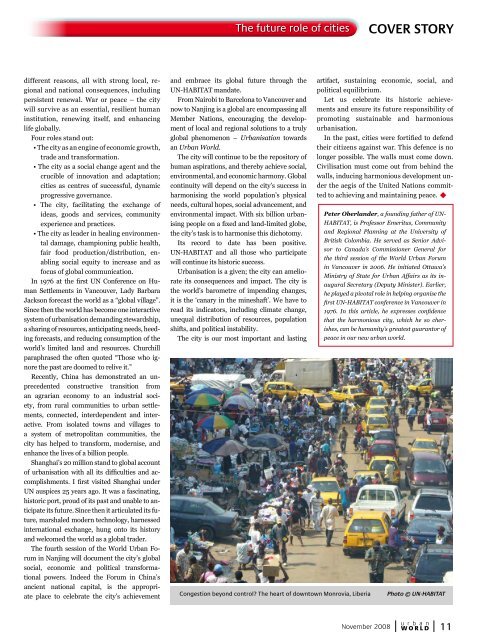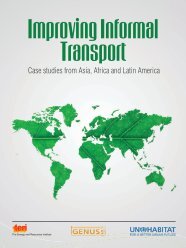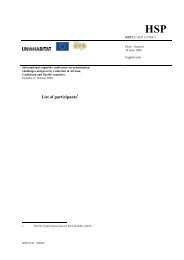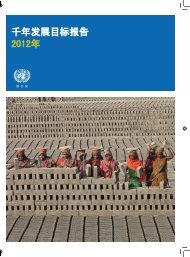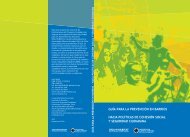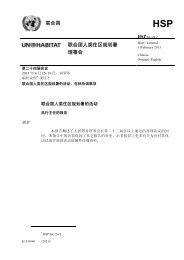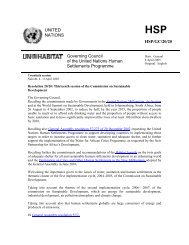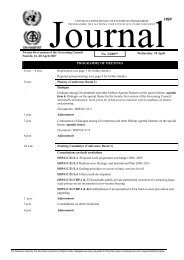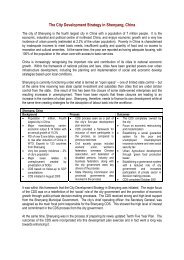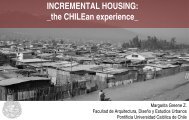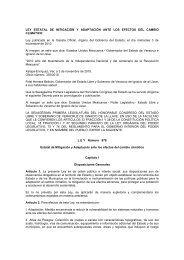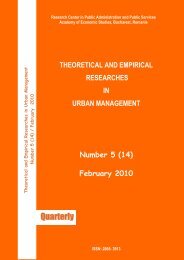Harmonious cities - UN-Habitat
Harmonious cities - UN-Habitat
Harmonious cities - UN-Habitat
You also want an ePaper? Increase the reach of your titles
YUMPU automatically turns print PDFs into web optimized ePapers that Google loves.
different reasons, all with strong local, regional<br />
and national consequences, including<br />
persistent renewal. War or peace – the city<br />
will survive as an essential, resilient human<br />
institution, renewing itself, and enhancing<br />
life globally.<br />
Four roles stand out:<br />
• The city as an engine of economic growth,<br />
trade and transformation.<br />
• The city as a social change agent and the<br />
crucible of innovation and adaptation;<br />
<strong>cities</strong> as centres of successful, dynamic<br />
progressive governance.<br />
• The city, facilitating the exchange of<br />
ideas, goods and services, community<br />
experience and practices.<br />
• The city as leader in healing environmental<br />
damage, championing public health,<br />
fair food production/distribution, enabling<br />
social equity to increase and as<br />
focus of global communication.<br />
In 1976 at the first <strong>UN</strong> Conference on Human<br />
Settlements in Vancouver, Lady Barbara<br />
Jackson forecast the world as a “global village”.<br />
Since then the world has become one interactive<br />
system of urbanisation demanding stewardship,<br />
a sharing of resources, anticipating needs, heeding<br />
forecasts, and reducing consumption of the<br />
world’s limited land and resources. Churchill<br />
paraphrased the often quoted “Those who ignore<br />
the past are doomed to relive it.”<br />
Recently, China has demonstrated an unprecedented<br />
constructive transition from<br />
an agrarian economy to an industrial society,<br />
from rural communities to urban settlements,<br />
connected, interdependent and interactive.<br />
From isolated towns and villages to<br />
a system of metropolitan communities, the<br />
city has helped to transform, modernise, and<br />
enhance the lives of a billion people.<br />
Shanghai’s 20 million stand to global account<br />
of urbanisation with all its difficulties and accomplishments.<br />
I first visited Shanghai under<br />
<strong>UN</strong> auspices 25 years ago. It was a fascinating,<br />
historic port, proud of its past and unable to anticipate<br />
its future. Since then it articulated its future,<br />
marshaled modern technology, harnessed<br />
international exchange, hung onto its history<br />
and welcomed the world as a global trader.<br />
The fourth session of the World Urban Forum<br />
in Nanjing will document the city’s global<br />
social, economic and political transformational<br />
powers. Indeed the Forum in China’s<br />
ancient national capital, is the appropriate<br />
place to celebrate the city’s achievement<br />
The future role of <strong>cities</strong><br />
and embrace its global future through the<br />
<strong>UN</strong>-HABITAT mandate.<br />
From Nairobi to Barcelona to Vancouver and<br />
now to Nanjing is a global arc encompassing all<br />
Member Nations, encouraging the development<br />
of local and regional solutions to a truly<br />
global phenomenon – Urbanisation towards<br />
an Urban World.<br />
The city will continue to be the repository of<br />
human aspirations, and thereby achieve social,<br />
environmental, and economic harmony. Global<br />
continuity will depend on the city’s success in<br />
harmonising the world population’s physical<br />
needs, cultural hopes, social advancement, and<br />
environmental impact. With six billion urbanising<br />
people on a fixed and land-limited globe,<br />
the city’s task is to harmonise this dichotomy.<br />
Its record to date has been positive.<br />
<strong>UN</strong>-HABITAT and all those who participate<br />
will continue its historic success.<br />
Urbanisation is a given; the city can ameliorate<br />
its consequences and impact. The city is<br />
the world’s barometre of impending changes,<br />
it is the ‘canary in the mineshaft’. We have to<br />
read its indicators, including climate change,<br />
unequal distribution of resources, population<br />
shifts, and political instability.<br />
The city is our most important and lasting<br />
COVER STORY<br />
artifact, sustaining economic, social, and<br />
political equilibrium.<br />
Let us celebrate its historic achievements<br />
and ensure its future responsibility of<br />
promoting sustainable and harmonious<br />
urbanisation.<br />
In the past, <strong>cities</strong> were fortified to defend<br />
their citizens against war. This defence is no<br />
longer possible. The walls must come down.<br />
Civilisation must come out from behind the<br />
walls, inducing harmonious development under<br />
the aegis of the United Nations committed<br />
to achieving and maintaining peace. u<br />
Peter Oberlander, a founding father of <strong>UN</strong>-<br />
HABITAT, is Professor Emeritus, Community<br />
and Regional Planning at the University of<br />
British Colombia. He served as Senior Advisor<br />
to Canada’s Commissioner General for<br />
the third session of the World Urban Forum<br />
in Vancouver in 2006. He initiated Ottawa’s<br />
Ministry of State for Urban Affairs as its inaugural<br />
Secretary (Deputy Minister). Earlier,<br />
he played a pivotal role in helping organise the<br />
first <strong>UN</strong>-HABITAT conference in Vancouver in<br />
1976. In this article, he expresses confidence<br />
that the harmonious city, which he so cherishes,<br />
can be humanity’s greatest guarantor of<br />
peace in our new urban world.<br />
Congestion beyond control? The heart of downtown Monrovia, Liberia Photo © <strong>UN</strong>-HABITAT<br />
u r b a n<br />
November 2008 WORLD 11


